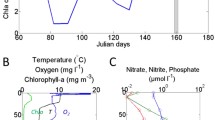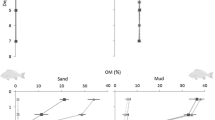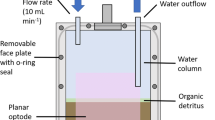Abstract
The possible impacts of resuspension of low-density bottom sediments on the microbial decomposition process of organic matter were investigated at a coastal fish farming area. Hydrolysis and mineralization rates were much higher in sinking particles, resuspendable particles, and bottom sediments than in seawater. The cell-specific mineralization rate of free-living bacteria in seawater was several times higher than that of particle-associated bacteria at the other three sites. Conversely, no significant difference was observed in the cell-specific ecto-enzymatic hydrolysis rate. These results indicated different strategies in the utilization of organic matter: free-living bacteria actively respire low-molecular-weight compounds produced from the high-molecular-weight compounds resulting from extracellular enzyme activity of particle-associated bacteria. Both hydrolysis and mineralization were higher in sinking particles than in the other three sites. Hydrolysis rates were higher in resuspendable particles than in bottom sediments. Furthermore, leucine aminopeptidase and mineralization rates tended to be highest during winter in all four sites within the water column. These results suggest that the microbial decomposition of organic matter is stimulated by the resuspension of bottom sediments, especially during winter, when vertical mixing is relatively strong.






Similar content being viewed by others
Change history
15 September 2017
Erratum to: Fish Sci (2017) 83:635–647 DOI 10.1007/s12562-017-1098-9.
References
Brown JR, Gowen RJ, McLusky DS (1987) The effect of salmon farming on the benthos of a Scottish sea loch. J Exp Mar Biol Ecol 109:39–51
Gowen RJ, Bradbury NB (1987) The ecological impact of salmoid farming in coastal waters: a review. Oceanogr Mar Biol Annu Rev 25:563–575
Wu RSS (1995) The environmental impact of marine fish culture: towards a sustainable future. Mar Pollut Bull 31:159–166
Alongi DM, Chong VC, Dixon P, Sasekumar A, Tirendi F (2003) The influence of fish cage aquaculture on pelagic carbon flow and water chemistry in tidally dominated mangrove estuaries of peninsular Malaysia. Mar Environ Res 55:313–333
Yoshikawa T, Eguchi M (2013) Planktonic processes contribute significantly to the organic carbon budget of a coastal fish-culturing area. Aquacult Environ Interact 4:239–250
Yoshikawa T, Kanemata K, Nakase G, Eguchi M (2012) Microbial mineralization of organic matter in sinking particles, bottom sediments and seawater in a coastal fish culturing area. Aquac Res 43:1741–1755
Kaspar HF, Hall GH, Holland AJ (1988) Effects of sea cage salmon farming on sediment nitrification and dissimlatory nitrate reductions. Aquaculture 70:333–344
Hall POJ, Anderson LG, Holby O, Kollberg S, Samuelsson MO (1990) Chemical fluxes and mass balances in a marine fish cage farm. I. Carbon. Mar Ecol Prog Ser 61:61–73
Holmer M, Kristensen E (1992) Impact of marine fish cage farming on metabolism and sulfate reduction of underlying sediments. Mar Ecol Prog Ser 80:191–201
Smith DC, Simon M, Alldredge AL, Azam F (1992) Intense hydrolytic enzyme activity on marine aggregates and implications for rapid particle dissolution. Nature 359:139–141
Grossart HP, Simon M (1998) Bacterial colonization and microbial decomposition of limnetic organic aggregates (lake snow). Aquat Microb Ecol 15:127–140
Azam F, Long RA (2001) Sea snow microcosms. Nature 414:495–498
Cromey CJ, Nickell TD, Black KD, Provost PG, Griffiths CR (2002) Validation of a fish farm water resuspension model by use of a particulate tracer discharged from a point source in a coastal environment. Estuaries 25:916–929
Keeley NB, Cromey CJ, Goodwin EO, Gibbs MT, Macleod CM (2013) Predictive depositional modelling (DEPOMOD) of the interactive effect of current flow and resuspension on ecological impacts beneath salmon farms. Aquacult Environ Interact 3:275–291
Wainright SC (1990) Sediment-to-water fluxes of particulate material and microbes by resuspension and their contribution to the planktonic food web. Mar Ecol Prog Ser 62:271–281
Chróst R, Riemann B (1994) Storm-stimulated enzymatic decomposition of organic matter in benthic/pelagic coastal mesocosms. Mar Ecol Prog Ser 108:185–192
Arfi R, Bouvy M (1995) Size, composition and distribution of particles related to wind induced resuspension in a shallow tropical lagoon. J Plankton Res 17:557–574
Pedersen OB, Christiansen C, Laursen MB (1995) Wind induced long term increase and short term fluctuations of shallow waters suspend mater and nutrient concentrations, Ringkobing Fjord, Denmark. Ophelia 41:273–287
Pusceddu A, Fiodelmondo C, Polymenakou P, Polychronaki T, Tselepides A, Danovaro R (2005) Effects of bottom trawling on the quantity and biochemical composition of organic matter in coastal marine sediments (Thermaikos Gulf, northwestern Aegean Sea). Cont Shelf Res 25:2491–2505
Simon M, Grossart HP, Schweitzer B, Ploug H (2002) Microbial ecology of organic aggregates in aquatic ecosystems. Aquat Microb Ecol 28:175–211
Azam F, Smith DC (1991) Bacterial influence on the variability in the ocean’s biogeochemical state: A mechanistic view. In: Demers S (ed) Particle Analysis in Oceanography. Springer, New York, pp 213–236
Grossart HP, Simon M (1998) Significance of limnetic organic aggregates (lake snow) for the sinking flux of particulate organic matter in a large lake. Aquat Microb Ecol 15:115–125
Grossart HP, Ploug H (1991) Microbial degradation of organic carbon and nitrogen on diatom aggregates. Limnol Oceanogr 46(2):267–277
Schweitzer B, Huber I, Amann R, Ludwig W, Simon M (2001) α- and β-proteobacteria control the consumption and release of amino acids on lake snow aggregates. Appl Environ Microbiol 67:632–645
Obayashi Y, Suzuki S (2005) Proteolytic enzymes in coastal surface seawater: significant activity of endopeptidases and exopeptidases. Limnol Oceanogr 50:722–726
Kimata M, Kawai A, Ishida Y (1960) The method for sampling of marine bottom muds. Nippon Suisan Gakkaishi 24:1227–1230
Eguchi M, Oketa T, Miyamoto N, Maeda H, Kawai A (1996) Occurrence of viable photoautotrophic picoplankton in the aphotic zone of Lake Biwa, Japan. J Plankton Res 18(4):539–550
Strickland JDH (1960) Measuring the production of marine phytoplankton. Fisheries Research Board of Canada Bulletin 122, Ottawa
Suzuki R, Ishimaru T (1990) An improved method for the determination of phytoplankton chlorophyll using N, N-dimethylformamide. J Oceanogr 46:190–194
Porter KG, Feig YS (1980) The use of DAPI for identifying and counting aquatic microflora. Limnol Oceanogr 25:943–948
Kuwae T, Hosokawa Y (1999) Determination of abundance and biovolume of bacteria in sediments by dual staining with 4′, 6-diamidino-2-phenylindole and acridine orange: relationship to dispersion treatment and sediment characteristics. Appl Environ Microbiol 65:3407–3412
Hoppe HG (1983) Significance of exoenzymatic activities in the ecology of brackish water: measurements by means of methylumbelliferyl-substrates. Mar Ecol Prog Ser 11:299–308
McKinley VL, Federle TW, Vestal JR (1983) Improvements in and environmental applications of double-vial radiorespirometry for the study of microbial mineralization. Appl Environ Microbiol 45:255–259
Sakami T, Yokoyama H, Ishihi Y (2005) Microbial hydrolytic enzyme activity in the sediments of a net cage aquaculture area. Fish Sci 71:271–278
Azua I, Unanue M, Ayo B, Artolozaga I, Arrieta JM, Iriberri J (2003) Influence of organic matter quality in the cleavage of polymers by marine bacterial communities. J Plankton Res 25:1451–1460
Ploug H (2001) Small-scale oxygen fluxes and remineralization in sinking aggregates. Limnol Oceanogr 46:1624–1631
Yoshikawa T, Murata O, Furuya K, Eguchi M (2007) Short-term covariation of dissolved oxygen and phytoplankton photosynthesis in a coastal fish aquaculture site. Est Coast Shelf Sci 74:515–527
Smith DC, Steward GF, Long RA, Azam F (1995) Bacterial mediation of carbon fluxes during a diatom bloom in a mesocosm. Deep-Sea Res II 42:75–97
Simon M, Jontofsohn M, Parparov A, Berman T (2000) Turnover of combined amino acids and carbohydrates on organic aggregates and in the bulk water in Lake Kinneret and other pelagic ecosystems. Arch Hydrobiol Spec Issue Adv Limnol 55:365–377
Kirchman DL, Dittel AI, Findlay SEG, Fischer D (2004) Changes in bacterial activity and community structure in response to dissolved organic matter in the Hudson River, New York. Aquat Microb Ecol 35:243–257
Patel AB, Fukami K, Nishijima T (2001) Extracellular proteolytic activity in the surface sediment of a eutrophic inlet. Microb Environ 16:25–35
Yokoyama H, Abo K, Ishii Y (2006) Quantifying aquaculture-derived organic matter in the sediment in and around a coastal fish farm using stable carbon and nitrogen isotope ratios. Aquaculture 254:411–425
Acknowledgements
We are grateful to O. Murata, the late S. Miyashita, S. Miyano, K. Kato, R. Konishi, and the other staff members of the Aquaculture Research Institute, Kindai University, for their cooperation at sea. We are also grateful to S. Yamochi and S. Fujiwara for their cooperation with CHN analysis. Financial support was provided by the 21st Century COE Program (the Center of Aquaculture Science and Technology for Bluefin Tuna and Other Cultivated Fish) and the Global COE Program (International Education and Research Center for Aquaculture Science of Bluefin Tuna and Other Cultured Fish) of MEXT, Japan, the Strategic Project to Support the Formation of Research Bases at Private Universities: matching fund subsidy from MEXT, Japan, 2014-2016 (S1412003).
Author information
Authors and Affiliations
Corresponding author
Additional information
An erratum to this article is available at https://doi.org/10.1007/s12562-017-1132-y.
Rights and permissions
About this article
Cite this article
Yoshikawa, T., Kanemata, K., Nakase, G. et al. Microbial decomposition process of organic matter in sinking particles, resuspendable particles, and bottom sediments at a coastal fish farming area. Fish Sci 83, 635–647 (2017). https://doi.org/10.1007/s12562-017-1098-9
Received:
Accepted:
Published:
Issue Date:
DOI: https://doi.org/10.1007/s12562-017-1098-9




